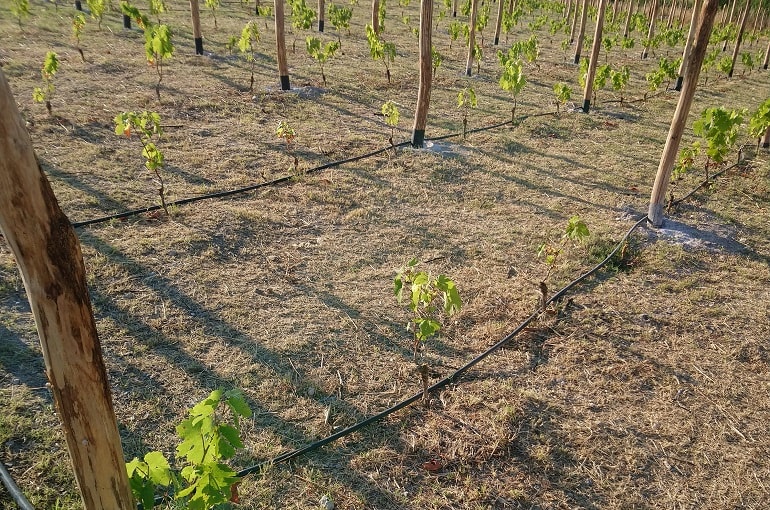Grapevines Planting and Plant spacing – Number of plants per hectare

This post is also available in:
This post is also available in:
![]() Español (Spanish)
Español (Spanish) ![]() Français (French)
Français (French) ![]() Deutsch (German)
Deutsch (German) ![]() Nederlands (Dutch)
Nederlands (Dutch) ![]() हिन्दी (Hindi)
हिन्दी (Hindi) ![]() العربية (Arabic)
العربية (Arabic) ![]() Türkçe (Turkish)
Türkçe (Turkish) ![]() 简体中文 (Chinese (Simplified))
简体中文 (Chinese (Simplified)) ![]() Русский (Russian)
Русский (Russian) ![]() Italiano (Italian)
Italiano (Italian) ![]() Ελληνικά (Greek)
Ελληνικά (Greek) ![]() Português (Portuguese (Brazil))
Português (Portuguese (Brazil)) ![]() Tiếng Việt (Vietnamese)
Tiếng Việt (Vietnamese) ![]() Indonesia (Indonesian)
Indonesia (Indonesian) ![]() 한국어 (Korean)
한국어 (Korean) ![]() polski (Polish)
polski (Polish)
Planting date depends on the vine variety, weather conditions and the grower’s preferences. Ideally, we could plant our benchgrafts during the entire winter period. However, the second half of the winter is the most suitable period in most cases.
Farmers generally prefer 1 year old rooted seedlings. Some producers prefer to plant benchgrafts by removing cuttings and graft them on rootstock varieties on their own. However, buying your plants from a legitimate seller is always the best possible solution.
After all the preparation steps described in the previous chapters, we can proceed with transplanting. Growers label the exact points on the soil where they will plant the young plants. During the previous century, they used ropes and stakes to be sure they will plant the vines linearly. Nowadays, technology helps farmers, as they use high precision lasers. They then dig holes 30-50 cm (12-20 inches) and plant the seedlings. Planting can be done either by hand or by using laser planters. The advantage of laser planters contrary to manual planting, is that the first are capable of planting quickly, with very high precision and at the right distances. On the other hand, they face difficulties in planting on inclined fields.
When it comes to rooted benchgrafts, it is important to plant them in such a depth so as to keep the connection point about 4-5 cm (1,6 – 2 inches) above the soil surface. If we cover the connection point, the scion will most probably develop roots. These roots will start to increase rapidly and will outmatch those of the rootstock. This would be a great problem. However, in countries with high risk of frost, some farmers used to cover the entire plant with soil after transplanting, in order to protect it. They then removed the extra soil together with any possible scion rooting a couple of weeks later.
As far as the planting distances and population are concerned, once again we have a lot of different patterns depending on the producing varieties, the soil structure, organic matter, the type of the vineyard and growing techniques. For example, at irrigated vineyards with fertile soil, a commonly used pattern includes up to 2000-2500 plants per hectare when it comes to table grapes and 3000-3500 plants per hectare for wine varieties with a yield of 10-12 tons per hectare.
For a population of 3000 to 4000 plants per hectare, many producers prefer to install their grapevines on distances 2 – 2,5m (6,5 to 8,2 feet) between rows and 1,25 – 1,35 m (4,1 – 4,4 ft.) between plants. Other producers prefer 2,5m (8,2 ft.) distance between rows and 1,15m (3,8 ft.) between plants. Keep in mind that 1 hectare = 2,47 acres = 10.000 square meters.
The second pattern is not recommended for all varieties. The reason is that by keeping such close distances between the plants in the row, the roots of the two neighboring plants may interfere. Distances less than 1 meter (3,3 ft.) between plants shall generally be avoided, as they will lead to foliar overlapping and crowding of plants, something that often results in poor aeration and decreased air circulation of the crop.
Most contemporary table grapes varieties require a 3 meters (9,8 ft.) distance between rows and 1,5 meters (5 ft.) distance between plants in the row.
Some farmers use special anti-hail nets. These nets also protect the crop from birds.
You can enrich this article by leaving a comment or photo of your vines planting distances and population.
Viticulture Definition – What is Viticulture?
How to Grow Grapes for Profit- Commercial Grape Grower’s Essential Guide
Soil Requirements and Preparation for Grapevine Farming
Grapevines Planting and Plant spacing – Number of plants per hectare
Grapes Training Systems and Methods
Vine Pruning, Defoliation and Thinning
Grapes Irrigation and Water Management
Common Grapevine Pest and Diseases
Grape Harvesting – When and How to Harvest Vineyard
Grape Yield per Hectare and Acre
The use of Technology in Contemporary Viticulture
Do you have experience in commercial Viticulture? Please share your experience, methods and practices in the comments below. All the content you add will be soon reviewed by our agronomists. Once approved, it will be added to Wikifarmer.com and it will influence positively thousands of new and experienced farmers across the world.








































































